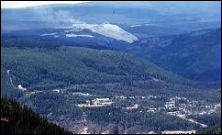Some Canadian Mining History
British Columbia has been one of the world's major mining regions since the mid-1800s and to this day is a key international player. Encompassing the largest part of the Canadian Cordillera, a mountain belt rich in minerals and coal, B.C. produces and exports a significant amount of copper, gold, silver, lead, zinc, molybdenum, coal and industrial minerals every year. Historically, B.C.'s vast mineral resources have contributed extensively to the province's growth and development. The Hudson's Bay Company first started producing coal on Vancouver Island in the 1840s, and the discovery of gold along the Fraser River in the 1850s sparked a major gold rush, which was ultimately responsible for the settlement of many parts of that region. As B.C.'s population increased, the provincial infrastructure improved, and miners were able to explore more and more of the province's terrain, leading to many new mineral deposit discoveries.
Throughout the century following the Fraser River Gold Rush, most mining activities in British Columbia took place underground. But in the early 1960s, the feasibility of open-pit production increased tremendously, and as a result, several huge copper mines opened, including Highland Valley Copper—the largest open-pit operation in all of North America.
